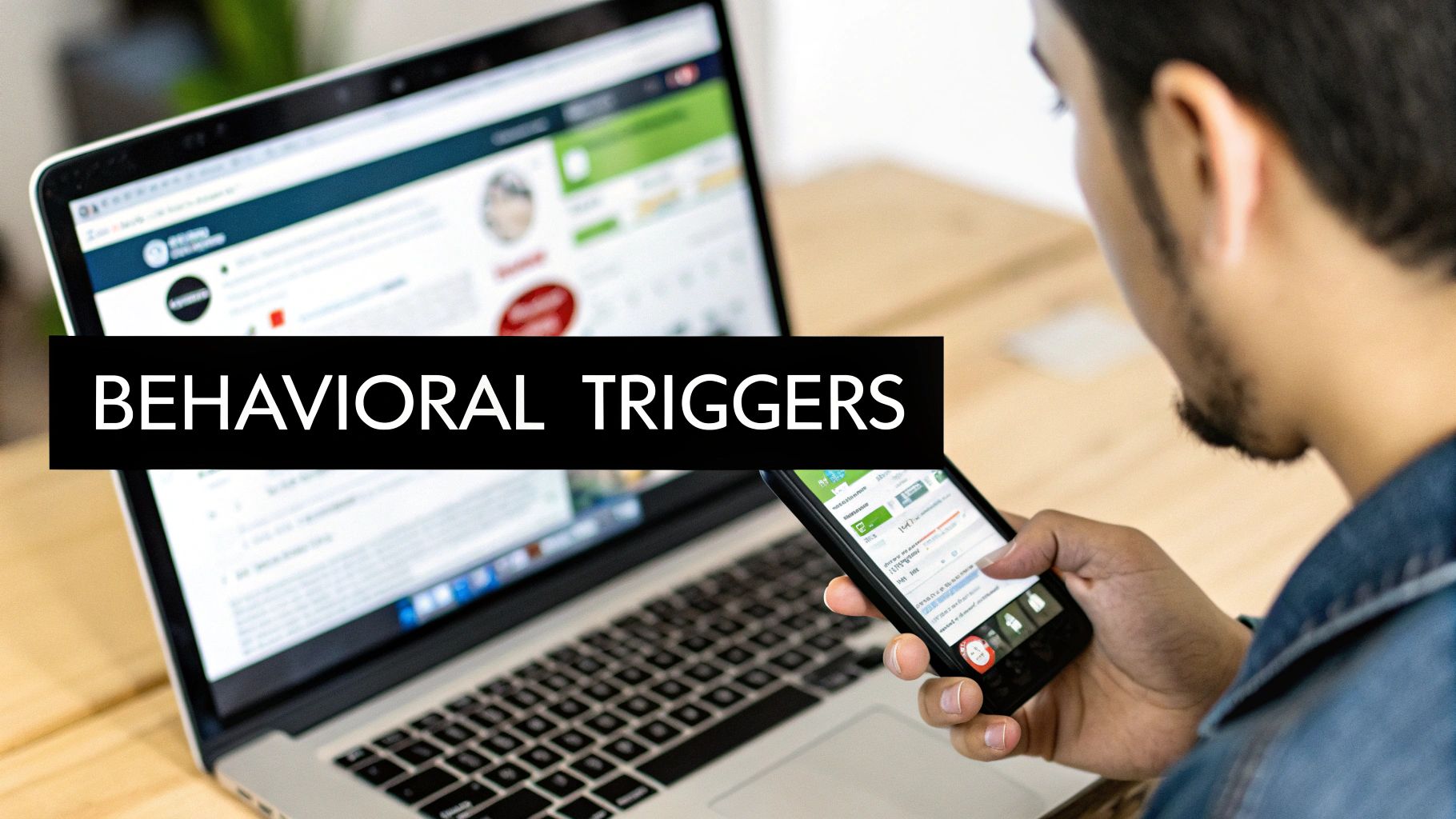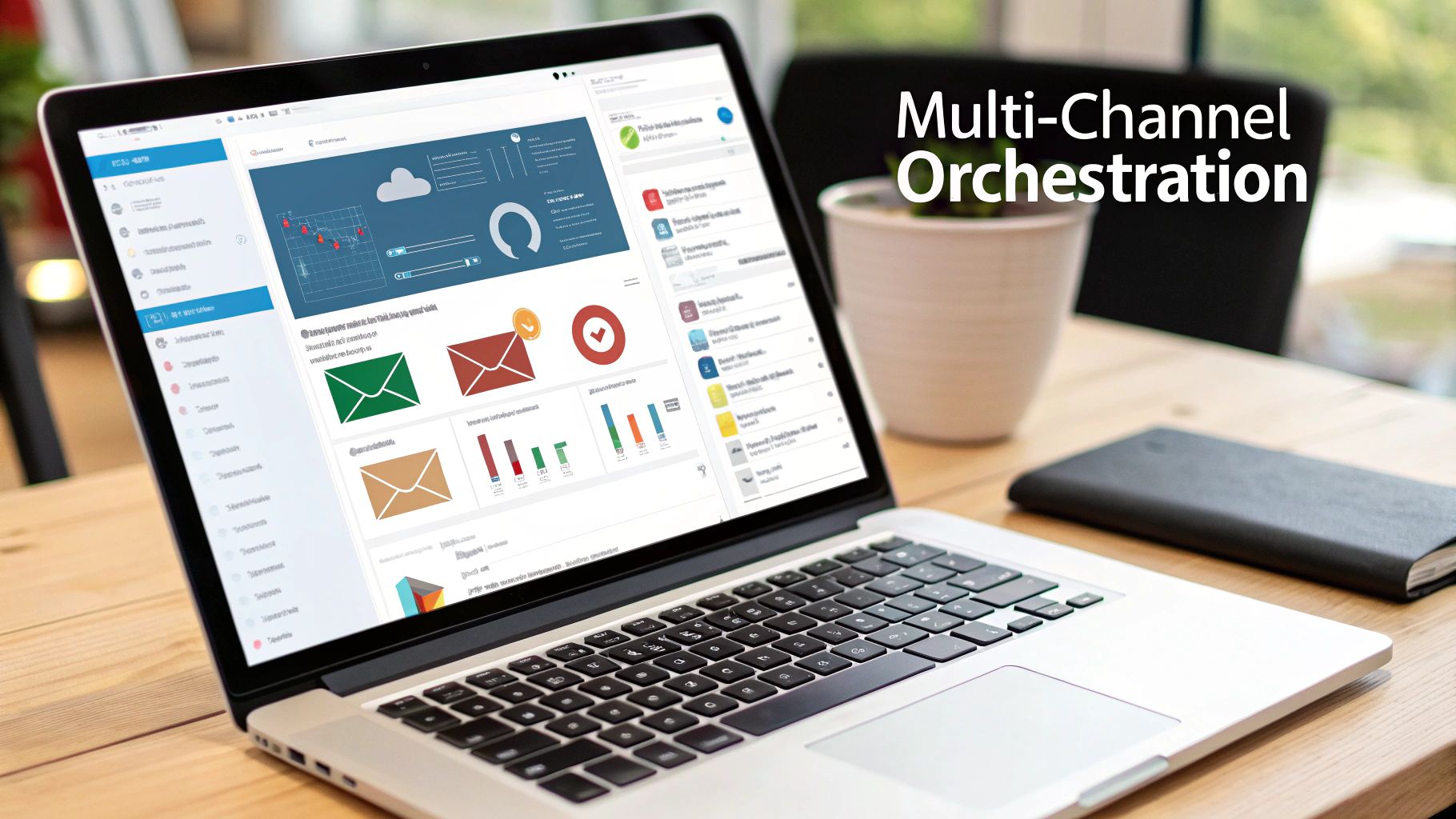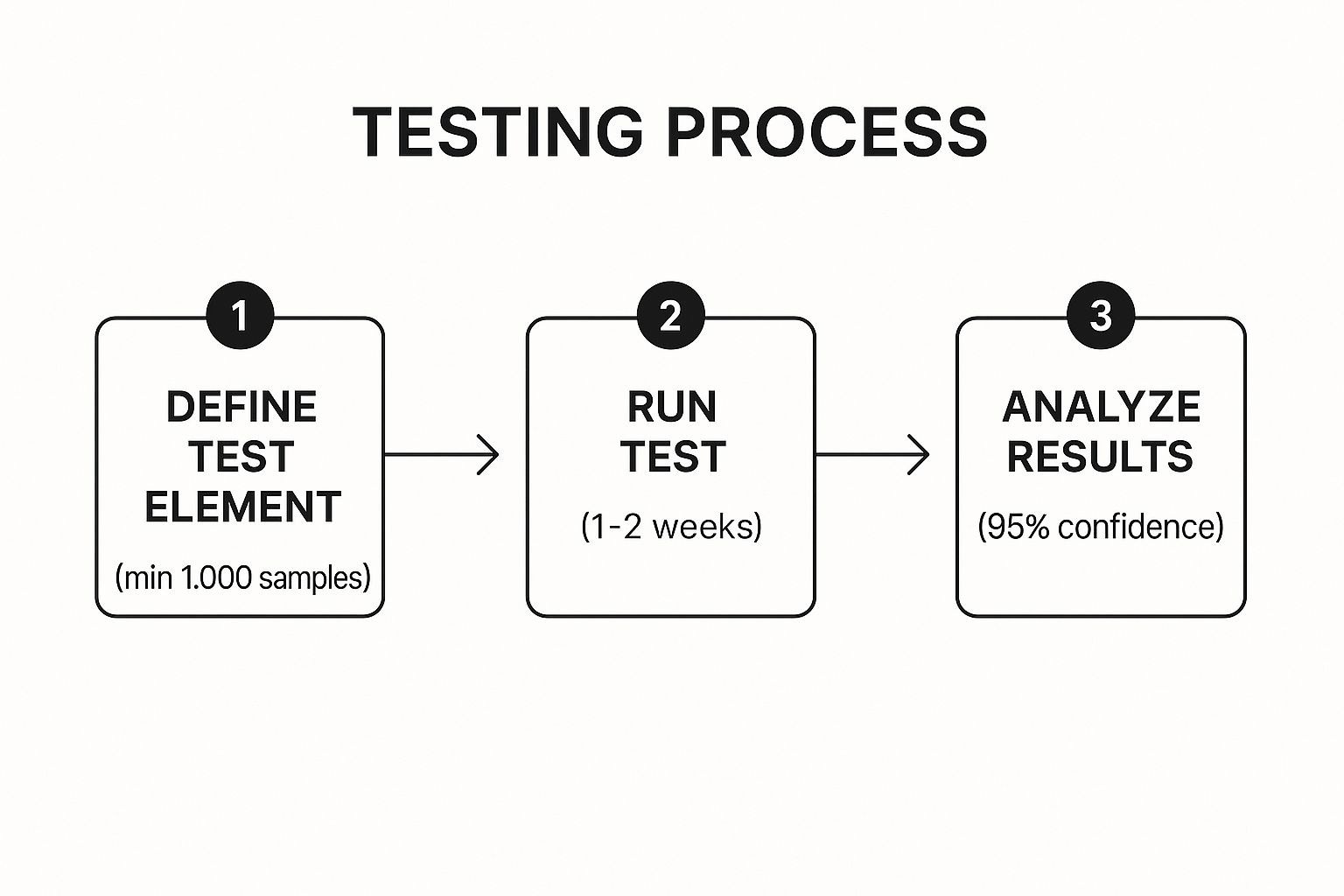Marketing automation promises a world of efficiency and unparalleled growth, yet many businesses find themselves stuck with expensive software that merely sends generic, batch-and-blast emails. The gap between potential and reality is not in the technology; it is in the strategy. True success lies in moving beyond basic triggers and embracing a sophisticated, data-driven approach that anticipates customer needs and personalizes every interaction at scale. If your platform feels more like an overpriced email sender than a revenue-generating machine, the problem likely lies in the execution, not the tool itself.
This guide cuts through the noise to deliver proven marketing automation best practices that transform your platform from a simple tool into a powerful growth engine. We will move past the obvious and provide actionable frameworks you can implement immediately. Forget surface-level tips; this is a comprehensive roundup designed for measurable results.
You will learn how to:
- Segment and personalize communications to resonate with specific audience needs.
- Implement behavioral triggers that deliver the right message at the perfect moment.
- Maintain pristine data hygiene to improve deliverability and campaign performance.
- Orchestrate multi-channel campaigns for a seamless customer experience.
- Align sales and marketing through intelligent lead scoring and CRM integration.
Each best practice is designed to help you build smarter workflows, foster stronger customer relationships, and generate a clear return on your automation investment. Let's begin.
1. Audience Segmentation and Personalization
Audience segmentation is the practice of dividing your contact database into smaller, targeted groups based on shared characteristics. Personalization then uses this data to tailor messaging, content, and offers to each segment's unique needs and preferences. This powerful combination transforms generic, one-size-fits-all campaigns into highly relevant, one-to-one conversations at scale.
This approach is one of the most fundamental marketing automation best practices because it directly addresses the modern consumer's expectation for relevant experiences. By sending the right message to the right person at the right time, you dramatically increase engagement, build stronger customer relationships, and drive higher conversion rates. Without proper segmentation, your automation efforts risk feeling impersonal and spammy, leading to unsubscribes and brand damage.

How Segmentation and Personalization Work in Practice
Companies excelling at this strategy see incredible results. Amazon famously attributes a significant portion of its revenue to its recommendation engine, which segments users based on browsing and purchase history. Similarly, Spotify’s "Discover Weekly" playlist is a masterclass in personalization, using listening behavior to deliver custom music selections that keep users deeply engaged with the platform.
Sephora’s Beauty Insider program segments members by their purchase history and stated preferences (like skin concerns or favorite brands). This allows them to send personalized product recommendations and targeted promotions that lead to significantly higher conversion rates compared to their non-segmented campaigns. These examples prove that a deep understanding of your audience is the bedrock of effective automation. For a deeper dive into this initial research phase, you can learn more about defining your target audience on copymasters.co.
Actionable Tips for Implementation
- Start Simple: Begin with 3-5 broad segments based on core data like demographics, purchase history, or website engagement. You can create more granular segments later.
- Use RFM Analysis: Segment your customer base using Recency, Frequency, and Monetary (RFM) data. This helps you identify high-value customers who may deserve special offers or loyalty campaigns.
- Automate Segment Flow: Set up rules in your automation platform to automatically move contacts between segments based on their actions. For example, a "Prospect" becomes a "New Customer" after their first purchase.
- Leverage Dynamic Content: Instead of creating dozens of separate emails, use dynamic content blocks that change based on the recipient's segment. This allows you to personalize a single email template for multiple audiences, saving significant time and effort.
2. Lead Nurturing with Drip Campaigns
Lead nurturing with drip campaigns is the process of building relationships with prospects by delivering a pre-written, automated sequence of messages over time. These campaigns "drip" relevant, timely content to leads based on schedules or behavioral triggers, guiding them through the buyer's journey from initial awareness to purchase readiness. This systematic approach ensures consistent communication and keeps your brand top-of-mind.
This strategy is one of the most essential marketing automation best practices because not all leads are ready to buy immediately. Drip campaigns automate the crucial middle-of-the-funnel process, educating and persuading prospects without manual intervention. By providing value consistently, you build trust and authority, ensuring that when a lead is ready to convert, your business is their first choice.
How Drip Campaigns Work in Practice
Companies that master automated nurturing see significant returns on their lead generation efforts. Slack, for example, uses an automated onboarding sequence that guides new users through key features over their first 14 days. This educational drip campaign is a major contributor to its impressive user retention rates. Similarly, Grammarly sends a 7-day onboarding drip to free users, highlighting premium features progressively and successfully converting a large percentage to paid subscribers.
Another great example is Salesforce, which implements industry-specific nurture campaigns. A lead from the financial sector receives case studies and whitepapers relevant to banking, while a healthcare lead gets content tailored to their unique challenges. This targeted approach results in significantly higher engagement rates compared to generic campaigns. These examples highlight how automated, relevant communication can effectively move prospects toward a decision. For more strategies on filling your funnel, you can explore how to generate leads online on copymasters.co.
Actionable Tips for Implementation
- Map Content to the Buyer's Journey: Align your drip sequence with the awareness, consideration, and decision stages. Early emails should educate and solve problems, while later emails can introduce your solution and special offers.
- Keep Sequences Concise: Start with a sequence of 5-7 emails. This is typically enough to build rapport and guide a prospect without causing fatigue or prompting unsubscribes.
- Pace Your Communication: Space initial emails 3-5 days apart to maintain momentum. You can extend the time between sends as the sequence progresses or if the lead shows lower engagement.
- Use Behavioral Triggers: Whenever possible, advance users in a drip campaign based on actions (like visiting a pricing page or downloading a guide) rather than just a time delay. This makes the communication far more relevant and timely.
- Establish Clear Exit Criteria: Automatically remove leads from a nurture sequence once they convert, book a demo, or are passed to the sales team. This prevents sending irrelevant messages to converted customers.
3. Behavioral Trigger-Based Automation
Behavioral trigger automation responds to specific actions (or inactions) taken by users, automatically sending relevant messages or executing workflows in real-time. Unlike scheduled campaigns, these automations react instantly to behaviors like website visits, email clicks, cart abandonment, or form submissions. This practice creates timely, contextually relevant interactions that feel personal and immediate.
This real-time responsiveness is one of the most powerful marketing automation best practices because it meets customers exactly where they are in their journey. Instead of waiting for a weekly newsletter, a user who abandons a shopping cart receives a helpful reminder within the hour. This immediacy dramatically increases the chances of engagement and conversion, turning potential missed opportunities into successful outcomes.

How Behavioral Triggers Work in Practice
The power of this strategy is evident across many industries. Warby Parker, for instance, sends abandoned cart emails with try-on reminders within two hours, recovering an estimated 20% of otherwise lost sales. Similarly, Dropbox triggers re-engagement emails when users approach their storage limits, successfully converting around 15% of those free users into paid subscribers by addressing an immediate need.
Canva uses a simple yet effective trigger, sending an email reminder about unfinished designs 48 hours after a user starts a project but does not complete it. This gentle nudge helps recover approximately 30% of abandoned designs, demonstrating the immense value of timely intervention. Pioneers like Amazon and Klaviyo have built their platforms around these sophisticated behavioral capabilities, proving their central role in modern marketing.
Actionable Tips for Implementation
- Map Critical Touchpoints: Identify key moments in the customer journey (like signup, first purchase, or feature discovery) where a triggered message would add significant value.
- Set Up Abandoned Cart Series: Create a multi-step sequence for abandoned carts. A common strategy is to send reminders at 1-hour, 24-hour, and 72-hour intervals, each with a slightly different message or incentive.
- Create a Welcome Series: Trigger an automated welcome email series immediately upon a new user signing up. This is your best chance to make a strong first impression and guide them toward a valuable first action.
- Use Page Visit Triggers: Send follow-up content related to specific pages a user has visited. If someone views your "pricing" page multiple times, trigger an email from a sales rep or a case study that justifies the cost.
- Implement Lead Scoring Triggers: Set up an automation that instantly notifies your sales team when a lead's score crosses a specific "sales-qualified" threshold, ensuring rapid follow-up.
4. Data Hygiene and List Management
Data hygiene is the process of regularly cleaning and maintaining your contact database to ensure accuracy, compliance, and deliverability. This practice includes removing invalid emails, updating contact information, managing unsubscribes, and suppressing inactive contacts. A clean, well-managed list is the foundation upon which all successful automation is built.
This is a critical marketing automation best practice because poor data quality can sabotage even the most sophisticated strategies. Inaccurate data leads to high bounce rates, which damages your sender reputation and can get your emails blacklisted. It also wastes resources on unreachable contacts and skews your analytics, making it impossible to accurately measure campaign performance.
How Data Hygiene Works in Practice
Leading companies understand that a smaller, engaged list is far more valuable than a massive, unmanaged one. After implementing quarterly data cleaning protocols that removed 30% of its inactive contacts, HubSpot saw its campaign performance improve by 40%. Similarly, Zillow uses real-time email verification at the point of capture on its forms. This simple step reduced its bounce rates to below 2% and helped maintain a stellar 98% deliverability rate.
These examples highlight a key principle: data quality trumps data quantity. By focusing on maintaining a healthy database, you ensure your messages reach the intended inboxes, protect your sender score, and generate more reliable performance metrics. For those looking for tools to support this, platforms like NeverBounce offer real-time verification and list cleaning services that integrate directly into automation workflows.
Actionable Tips for Implementation
- Verify at Point of Entry: Use real-time validation APIs on all your forms to prevent invalid or misspelled email addresses from entering your database in the first place.
- Automate Bounce Management: Set up rules to immediately remove hard bounces. For soft bounces, which can be temporary, automatically try resending 3-5 times before removing the contact.
- Run Re-engagement Campaigns: Before purging inactive contacts, run a targeted re-engagement or "win-back" campaign for subscribers who haven't opened an email in over six months.
- Schedule Regular Cleanups: Conduct a comprehensive database audit and cleaning session at least quarterly. This includes deduplicating records, standardizing data formats, and removing contacts who haven't engaged in over a year.
5. Multi-Channel Marketing Orchestration
Multi-channel marketing orchestration is the practice of coordinating automated campaigns across multiple communication platforms like email, SMS, social media, and in-app messaging. Instead of running separate, siloed campaigns on each channel, orchestration ensures that every message is part of a single, unified customer conversation. The goal is to deliver a consistent and contextually relevant experience that adapts to customer behavior and channel preference.
This strategy is one of the most impactful marketing automation best practices because it meets customers where they are. In today's fragmented digital landscape, relying on a single channel is no longer sufficient. By orchestrating communication, you create a seamless journey that feels personal and cohesive, which builds brand trust, boosts engagement, and respects customer communication preferences.

How Multi-Channel Orchestration Works in Practice
Leading brands use orchestration to create incredibly immersive experiences. Starbucks leverages its mobile app, email, and SMS to deliver personalized offers that seamlessly integrate with its rewards program, driving a massive portion of its total transactions. Similarly, Sephora coordinates its email, mobile app, and in-store communications to create a unified experience, resulting in remarkably high cross-channel customer engagement.
These strategies are often powered by platforms designed for this purpose. Tools from Salesforce Marketing Cloud and Adobe Experience Cloud provide enterprise-level solutions, while platforms like Omnisend offer powerful multi-channel automation specifically for e-commerce. These examples show that a well-orchestrated, multi-channel approach is key to creating a modern, customer-centric marketing ecosystem.
Actionable Tips for Implementation
- Start Small: Begin by orchestrating two or three of your most effective channels, such as email and SMS. Master the coordination between them before adding more complexity.
- Establish a Preference Center: Allow customers to choose how they want to hear from you. This respects their preferences and ensures your messages are received on the channels where they are most likely to engage.
- Assign Channel Roles: Use each channel for its strengths. For instance, use email for detailed storytelling, SMS for urgent time-sensitive alerts, and social media for community building.
- Implement Universal Frequency Caps: Prevent message fatigue by setting a global limit on the number of communications a contact can receive across all channels within a specific period (e.g., no more than five touchpoints per week).
6. A/B Testing and Continuous Optimization
A/B testing, also known as split testing, is the methodical practice of comparing two or more variations of a marketing asset to determine which performs better. This could be anything from email subject lines and calls-to-action to entire automation workflows. Continuous optimization elevates this into an ongoing, data-driven discipline where you constantly test, learn, and iterate to achieve compounding performance gains over time.
This is one of the most critical marketing automation best practices because it removes guesswork from your strategy. Instead of relying on assumptions, you let actual customer behavior guide your decisions. This scientific approach ensures your marketing efforts become progressively more effective, maximizing ROI and preventing campaign stagnation by adapting to evolving audience preferences.
The infographic below outlines a simplified, structured process for conducting an effective A/B test.

Following this disciplined flow ensures your test results are statistically significant and provide clear, actionable insights for improvement.
How A/B Testing Works in Practice
The power of testing is proven across industries. Barack Obama's 2008 presidential campaign famously used A/B testing on email subject lines and landing pages, which reportedly increased donation rates by 40%. In a classic growth-hacking example, Hotmail tested different email signatures, finding that "Get your free email at Hotmail" dramatically outperformed others, helping them scale to 12 million users in 18 months.
More recently, the team at Groove, a customer service software company, tested personalized vs. non-personalized subject lines for a blog update email. Counter to conventional wisdom, they discovered the non-personalized version performed significantly better with their specific audience, proving that you must test your own assumptions. For more ideas on what to test, you can explore these data-driven conversion rate optimization tips on copymasters.co.
Actionable Tips for Implementation
- Isolate Variables: Test only one element at a time (e.g., the headline or the CTA button color, but not both). This ensures you know exactly what caused the change in performance.
- Ensure Statistical Significance: Use a large enough sample size, typically a minimum of 1,000 contacts per variation for an email test, and run the test until you reach at least a 95% statistical confidence level.
- Test for a Full Cycle: Run tests for at least one full business week to account for performance variations on different days.
- Document Everything: Maintain a centralized log of all tests, including your hypothesis, the variations, the results, and the key learnings. This repository becomes an invaluable strategic asset over time.
7. Lead Scoring and Qualification
Lead scoring is the process of assigning numerical values, or points, to each lead you generate based on their professional information and their engagement with your brand. This system helps you prioritize leads, ensuring that your sales team focuses their valuable time on prospects who are most likely to convert, while marketing continues to nurture those who are not yet ready.
This methodical approach is one of the most impactful marketing automation best practices because it creates a crucial bridge between your marketing and sales departments. By automating the qualification process, you eliminate guesswork and ensure a consistent, data-driven handover of sales-ready leads. This alignment boosts efficiency, shortens the sales cycle, and significantly improves your overall return on investment.
How Lead Scoring and Qualification Work in Practice
Companies that master lead scoring gain a powerful competitive advantage. For example, Lenovo implemented a lead scoring model that resulted in a 175% increase in marketing-generated revenue by systematically directing sales efforts toward the highest-scoring leads. Similarly, Dell focused its team on leads scoring 70 or more out of 100, generating an impressive $1 million in pipeline within the first month of implementation.
Salesforce enhances this process by using predictive lead scoring, where AI analyzes historical data to identify the patterns of successful conversions, improving qualification accuracy by over 40%. These examples demonstrate that a well-defined scoring system is essential for scaling your sales efforts effectively. To further enhance your lead scoring and qualification processes, consider how advanced tools, such as those leveraging AI-powered lead generation strategies, can refine and streamline these critical marketing automation functions.
Actionable Tips for Implementation
- Define Your Ideal Customer: Work with your sales team to analyze your best customers. Identify the common firmographic characteristics (industry, company size) and high-value behaviors that indicate strong buying intent.
- Assign Points Strategically: Give higher scores to actions that signal explicit interest. For instance, a "demo request" might be worth 50 points, while a "pricing page visit" gets 20, and a "case study download" receives 15.
- Incorporate Negative Scoring: Deduct points for actions or attributes that indicate a poor fit. A competitor's email domain could subtract 50 points, while an unsubscribe might deduct 10.
- Set a Qualification Threshold: Determine the score at which a lead is considered "sales-ready" and automatically routed to your sales team. This is typically the point where conversion rates show a significant increase.
- Implement Score Decay: To keep your data fresh, automatically reduce a lead's score (e.g., by 5 points per month) if they become inactive. This ensures your sales team isn't chasing stale opportunities.
- Review and Refine Quarterly: Lead scoring isn't a "set it and forget it" task. Regularly analyze the outcomes of your scored leads and adjust your point values based on which attributes and actions actually lead to closed deals.
8. Integration with CRM and Sales Enablement
Integrating your marketing automation platform with a Customer Relationship Management (CRM) system bridges the critical gap between marketing and sales. This practice creates a unified, bidirectional flow of data, giving both teams a complete 360-degree view of every prospect and customer. Sales teams gain valuable insights into marketing engagement, while marketing can track leads all the way through to closed revenue.
This alignment is one of the most impactful marketing automation best practices because it directly ties marketing efforts to revenue generation. By creating a seamless handoff process and providing sales with real-time intelligence on lead behavior, you accelerate the sales cycle and dramatically improve conversion rates. This "closed-loop reporting" proves marketing's ROI and transforms the relationship between marketing and sales from siloed departments into a cohesive revenue-generating team.
How Integration Works in Practice
Companies that master this integration see transformative results in efficiency and pipeline growth. Cisco, by integrating Marketo with Salesforce, was able to create detailed closed-loop reports that directly attributed an astonishing $1 billion in pipeline to specific marketing activities. This level of clarity allowed them to double down on what worked and optimize their entire strategy.
Similarly, Thomson Reuters leveraged their integrated systems to provide sales reps with better lead intelligence, which helped them reduce their average sales cycle time by a remarkable 72%. Fujitsu took this further by setting up automated lead routing based on product interest and geography, ensuring new inquiries were assigned to the right specialist in under an hour. These examples show how a unified system empowers sales teams to have more relevant conversations and close deals faster.
Actionable Tips for Implementation
- Map Data Fields Meticulously: Before syncing, carefully map the fields between your marketing automation platform and CRM. Ensure critical data like lead source, engagement score, and key behaviors flow in both directions.
- Establish a Clear Handoff Protocol: Define the exact criteria for a Marketing Qualified Lead (MQL) and automate the process of assigning it to a sales rep in the CRM. This creates a clear, consistent handoff.
- Configure Real-Time Sales Alerts: Set up automated alerts to notify sales reps of high-intent activities, such as a prospect visiting the pricing page or downloading a case study. Be mindful to avoid alert fatigue by only notifying them of the most critical actions.
- Automate Lead Status Updates: As a sales rep works an opportunity in the CRM, their status updates (e.g., "Contacted," "Meeting Scheduled") should automatically sync back to the marketing platform. This keeps marketing informed and prevents them from sending inappropriate messages to an engaged lead.
Marketing Automation Best Practices Comparison
| Aspect | Audience Segmentation and Personalization | Lead Nurturing with Drip Campaigns | Behavioral Trigger-Based Automation | Data Hygiene and List Management | Multi-Channel Marketing Orchestration | A/B Testing and Continuous Optimization | Lead Scoring and Qualification | Integration with CRM and Sales Enablement |
|---|---|---|---|---|---|---|---|---|
| 🔄 Implementation Complexity | High complexity due to multi-dimensional segments and maintenance | Moderate complexity with content creation and logic setup | High complexity requires robust tech and workflow planning | Moderate; requires ongoing cleaning and validation processes | Very high complexity; multi-platform integrations and strategies | Moderate to high; setup, monitoring, and statistical analysis | High complexity with scoring rules and ongoing refinement | High complexity; technical challenges and maintenance required |
| 💡 Resource Requirements | Extensive data infrastructure and continuous updates | Significant upfront content and automation resources | Advanced integration, real-time tracking tech, and monitoring | Dedicated team/time for regular cleaning and audits | Multiple platforms, technology, and skilled multi-channel team | Skilled analysts and sufficient traffic for meaningful tests | Skilled analysts plus accurate data sources needed | Technical team for integrations and data governance |
| 📊 Expected Outcomes | ⭐⭐ High engagement & conversion lift; better targeting & relevance | ⭐ High lead engagement and conversion; nurtures buyer journey | ⭐⭐⭐ Highest transactional lift; real-time personalized responses | Improved email deliverability, compliance, and data accuracy | ⭐⭐⭐ Highest engagement via unified multi-channel approach | Steady, data-driven performance improvements and risk reduction | ⭐⭐ Increased lead prioritization and sales alignment | ⭐⭐ Increased sales productivity with accurate lead insights |
| Ideal Use Cases | Targeted campaigns requiring detailed segmentation and personalization | Automated lead education and engagement over time | Real-time engagement triggered by specific customer behaviors | Maintaining clean, compliant, and effective marketing lists | Brands needing unified multi-channel engagement and messaging | Marketers optimizing content and workflows through testing | Sales and marketing teams needing qualified lead prioritization | Organizations with CRM requiring marketing-sales alignment |
| Key Advantages | ⚡ Delivers relevant content; improves customer experience | ⚡ Consistent, scalable communication; maintains engagement | ⚡ Timely, contextually relevant communication; boosts conversions | ⚡ Enhances deliverability & compliance; reduces wasted spend | ⚡ Maximizes reach and engagement; coordinated omni-channel flow | ⚡ Removes guesswork; drives continuous improvement | ⚡ Objective prioritization; aligns sales/marketing efforts | ⚡ Real-time data sync; closed-loop reporting; faster follow-ups |
Turn Automation Into Your Competitive Advantage
The journey through marketing automation best practices reveals a fundamental truth: automation is not about replacing the human element, but amplifying it. It’s a powerful engine, but one that requires a skilled operator to navigate. We’ve explored the essential pillars of a successful strategy, moving from foundational concepts to advanced optimization techniques that separate thriving brands from those just going through the motions.
At its core, success is not about flipping a switch and watching leads pour in. It’s about a deliberate, strategic commitment to understanding your audience on a deeper level. The practices covered in this guide, from hyper-granular audience segmentation and personalized drip campaigns to sophisticated lead scoring, all serve a single purpose: to deliver the right message to the right person at the right time. This is the new standard for customer experience, and automation is the framework that makes it possible at scale.
From Automation to Intelligent Orchestration
The real paradigm shift occurs when you stop viewing these practices in isolation and start seeing them as interconnected parts of a larger ecosystem. Your behavioral triggers are only as effective as your data hygiene. Your multi-channel orchestration will fall flat without continuous A/B testing and optimization. And your sales team’s effectiveness hinges on the seamless integration between your marketing automation platform and your CRM.
Consider this progression:
- Level 1: Basic Automation. You schedule emails and set up simple welcome series. This saves time but barely scratches the surface of what’s possible.
- Level 2: Strategic Automation. You implement lead nurturing, basic segmentation, and triggers. You are actively guiding prospects through a pre-defined journey.
- Level 3: Intelligent Orchestration. You have a fully integrated system where data flows freely between marketing and sales. Behavioral data from multiple channels informs dynamic lead scoring, and every interaction is a data point used to refine and personalize the next. This is where you build a true competitive advantage.
Achieving this level of sophistication requires a commitment to continuous learning and adaptation. Markets shift, customer expectations evolve, and technology advances. The marketing automation best practices you implement today are the foundation for the innovations you will adopt tomorrow. To truly differentiate and achieve a significant edge in your market, exploring cutting-edge technologies like AI-powered marketing automation solutions can transform your strategy from reactive to predictive, anticipating customer needs before they are even expressed.
Your Actionable Blueprint for Success
Mastering marketing automation is a marathon, not a sprint. The sheer volume of possibilities can feel overwhelming, but progress begins with a single, focused step. Don't try to implement everything at once. Instead, identify the one area that promises the most significant impact for your business right now.
Is your lead handoff process with sales broken? Start by refining your lead scoring model and CRM integration. Are your engagement rates stagnant? Focus on implementing behavioral triggers to send more relevant, timely communications. Are you unsure what’s working? Make a firm commitment to rigorous A/B testing on your most critical campaigns.
By adopting an iterative approach, you build momentum. Each small win provides valuable data, builds internal confidence, and funds the next initiative. Remember, the ultimate goal is to create a seamless, valuable, and personalized experience for your audience. When you use automation to foster genuine connection and solve customer problems, you aren’t just generating leads; you are building relationships and creating brand advocates for life. The blueprint is in your hands. Now is the time to build.
Is your marketing automation engine starving for high-quality content? Fuel your campaigns with expertly crafted, SEO-optimized articles and copy from Copy Masters. We create the valuable content that makes every automated touchpoint count. Visit Copy Masters to see how we can power your content strategy.
- SaaS SEO Consulting for Predictable Growth - October 20, 2025
- What Is SEO Management Your Guide to Real Results - October 19, 2025
- A Guide to Quality Content for SEO That Ranks - October 18, 2025
